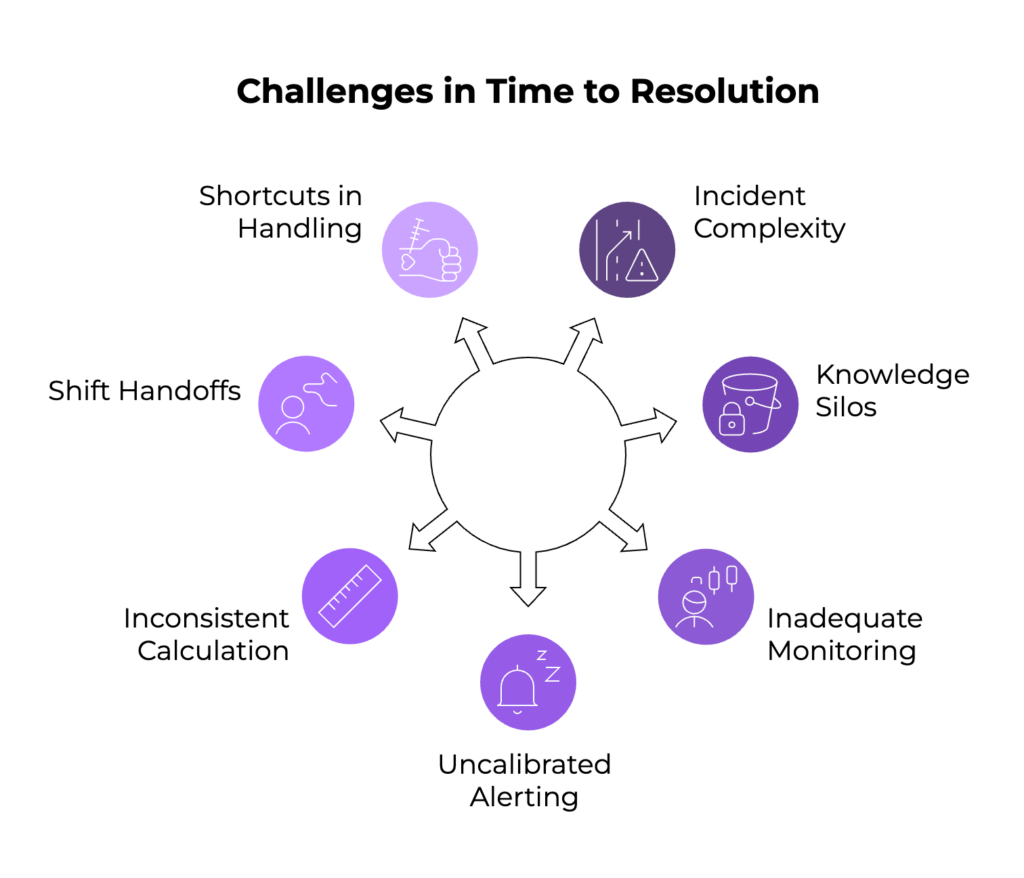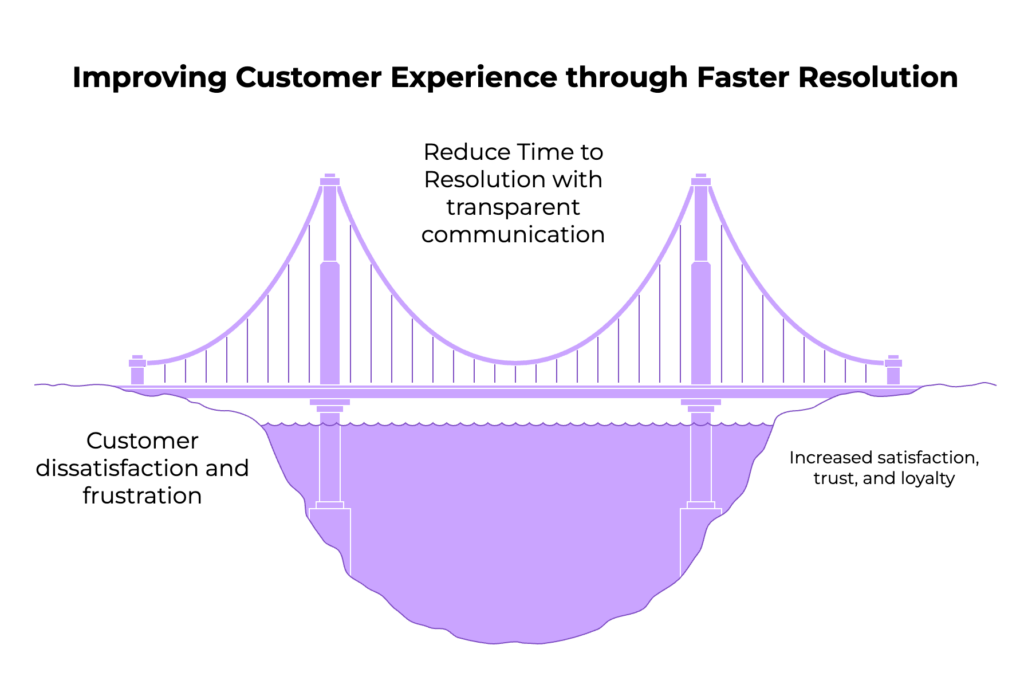Mastering Time to Resolution (TTR) in Customer Support : The Ultimate Guide to Reducing Incident Resolution Time for Business Success
Learn what Time to Resolution (TTR) is, why it matters, and how to optimize it with data-backed tactics that drive faster support and better user experiences.
Time to Resolution (TTR) plays a pivotal role in ensuring customer satisfaction and operational efficiency.
In this comprehensive guide, we’ll dive deep into the nuances of Time to Resolution-what it is, why it matters, how to accurately calculate it, and strategic methodologies to improve it. We also explore related metrics like MTTR (Mean Time to Resolution), industry benchmarks, and leverage advanced tools and technologies that optimize incident handling.
What Is Time to Resolution?
Time to Resolution (TTR) measures the total elapsed time from when an incident is first reported or detected until it is fully resolved. In other words, it’s the clock that starts ticking at issue detection and stops when the root cause is fixed and the system or service is restored to its normal operation.
Resolution means the problem is not only mitigated temporarily but addressed in a way that prevents recurrence-this is a crucial distinction. For example, a quick patch might allow service to resume, but the issue isn’t truly resolved until underlying bugs or infrastructure flaws are fixed, and clean-up or preventative measures are in place.
Notably, TTR encompasses all phases of incident management-from initial diagnosis, through troubleshooting and repair, to verification and cleanup. It reflects the entire resolution lifecycle, involving multiple teams, steps, and sometimes complex coordination.
In many systems, TTR can be further segmented into:
- Response Time: Time from incident report to first acknowledgment or action.
- Resolution Time: Time from incident report to final fix and closure.
Understanding the exact definition in your organization matters, as some may define it narrowly (time to “restore”) while others emphasize mean time to resolution as encompassing thorough problem-solving.
Let’s explore why TTR has become a non-negotiable KPI in customer support.
How to Calculate Time to Resolution

Calculating TTR accurately requires precise time-tracking of incident lifecycle stages and a sound definition of incident boundaries:
- Start Time: Typically the timestamp when the incident is created or reported in the system.
- End Time: Moment when the incident is marked resolved/closed with no outstanding issues.
- Exclude Non-Working Periods (If Applicable): Many organizations calculate TTR in business hours, excluding nights, weekends, and holidays for accurate SLA compliance measurement. For example, an incident created late Friday afternoon might only have active resolution time counted during the next business day.
- Consider SLA Calendars and Timezones: TTR calculations often leverage service calendars reflecting working hours and regional differences. Tools like Creatio automate this by applying calendars and SLA rules to convert calendar time into realistic working timeframes.
- Account for Multiple Calculation Rules: Organizations can define multiple calculation strategies, such as by service, priority, or support level, with fallback rules to ensure deadlines are determined even if one path fails.
Example:
An incident logged at 4:00 PM on Friday with a resolution time of 8 work hours will ideally resolve by 12:00 PM the following Monday, assuming a 9-to-5 business calendar excludes weekend time.
Why Is Time to Resolution Important?

TTR is a paramount Key Performance Indicator (KPI) for IT operations, customer support, and software teams because:
- Direct Impact on Customer Satisfaction: The duration a customer or user is affected by an issue directly correlates with their satisfaction.
- Financial Consequences: Downtime or degraded performance translates to lost revenue, operational inefficiencies, and potential contractual penalties in Service Level Agreements (SLAs).
- Operational Efficiency: Fast resolution reduces the amount of follow-up work, rework, and resource strain on technical teams, freeing them to focus on innovation instead of firefighting.
- Risk Management: A quick resolution lowers the exposure window when security breaches or compliance risks could be exploited.
- Supports Continuous Improvement: Tracking TTR highlights process weaknesses and enables targeted training, tooling investments, or workflow optimizations.
In essence, TTR acts as a health indicator for your incident response and resolution mechanisms. Ignoring it can cause persistent bottlenecks, ongoing customer frustration, and a lack of trust in your product or service.
The importance is clear — now, let’s look at the measurable benefits.
Benefits of Measuring Time to Resolution
Measuring TTR systematically offers several well-documented benefits:
- Identifies Bottlenecks and Inefficiencies: By analyzing TTR trends, organizations can pinpoint slow phases in incident management, such as lack of effective monitoring or delayed escalation.
- Supports SLA Compliance and Contract Management: Enables accurate reporting and SLA adherence, fostering transparency with customers and partners.
- Facilitates Resource Planning and Prioritization: Knowing typical TTRs helps allocate appropriate staff, schedule shifts, and prioritize high-impact incidents.
- Drives Accountability: Clear TTR metrics help in defining roles during incident response, encouraging ownership.
- Encourages Data-Driven Improvements: Regular review of TTR data informs investment in automation, monitoring, and training.
- Enables Benchmarking: Organizations can compare their performance against industry standards, set realistic improvement targets, and track progress over time (e.g., MetricNet’s global benchmarks).
Without measuring TTR, teams operate in the dark, guessing at pain points instead of addressing the root causes effectively.
Clearly defining and automating TTR calculation safeguards consistency and fairness in reporting. How does your organization’s TTR compare to the industry?
Average Time to Resolution (TTR) and Benchmarks
Understanding industry standards and averages provides useful context to evaluate your team’s performance against peers.
- Average TTR: Per MetricNet’s global data for desktop IT support, the average incident resolution time is approximately 8.85 business hours, with observed ranges from as low as 0.6 hours to as high as 27.5 hours depending on organizational factors.
Factors Influencing TTR:
- User Density: High-density office environments lower travel or coordination time and reduce TTR.
- Geographic Distribution: Spread-out user bases increase technician travel and coordination time, lengthening TTR.
- Incident Complexity: Complex multi-system outages naturally require longer resolution cycles.
- Setting Benchmarks: Understand your typical incident types and complexity to set realistic TTR targets. For example:
- Critical incidents: Target resolution within 30 minutes to 2 hours.
- Medium-impact incidents: May warrant 4-8 hours.
- Low-impact incidents: Can range up to multiple business days.
Benchmarking against averages like MetricNet’s can reveal where your teams stand and highlight opportunities for improvement.
Let’s clarify how MTTR complements (but doesn’t replace) TTR.
Understanding Mean Time to Resolution (MTTR)
MTTR is a statistically averaged form of TTR, focusing on the mean time it takes to resolve incidents over a period.
- Multiple Definitions: Originally from manufacturing (machine repair), in IT and DevOps circles MTTR is now understood chiefly as either mean time to restore or mean time to resolution.
- Mean Time to Restore focuses on the immediate recovery effort (getting the system back up).
- Mean Time to Resolution is broader, emphasizing full problem remediation including permanent fixes and cleanups.
- MTTR as an Indicator, Not a Panacea: It’s an average, which can be skewed by outliers-either very trivial or extraordinarily challenging incidents.
- Complement with Other Metrics: Best practice suggests using MTTR alongside error budgets, service availability percentages, and incident severity weights to get a full picture.
- Statistical Insights: MTTR alone doesn’t capture timing impact nuances, like whether problems occur during peak hours-a critical consideration as downtime at peak can cost more.
By understanding the statistical nature and limitations of MTTR, organizations avoid “quick fix” mentality and focus on sustainable reliability improvements.
Differences Between Time to Resolution and Related Metrics
Several related metrics often cause confusion. Here’s how TTR differs from them:
- Time to Response (TTRsp): How long it takes to acknowledge or start working on an incident. This is just the opening part of resolution and important for SLA compliance but not the entire fix.
- Mean Time to Repair (MTTR): Originally meant for physical asset repair, but often used interchangeably with mean time to resolution in IT.
- Mean Time Between Failures (MTBF): Measures reliability by averaging the time between incidents, not their resolution.
- Downtime / Outage Duration: Often measured in calendar time, including non-working hours, which may differ from business-hour-based TTR.
- First Contact Resolution (FCR): Percentage of issues resolved on first contact, which may correlate with shorter TTR but is a qualitative metric.
Clarifying these terms within your team avoids miscommunication and helps ensure that performance improvement efforts target the right processes.
But even the best metrics can be hard to manage without addressing these challenges.
Common Challenges in Measuring and Managing Time to Resolution

Despite its value, managing TTR in the real world presents some major challenges. Accurately measuring and managing TTR faces several real-world hurdles:
- Incident Complexity and Troubleshooting: Modern software systems are complex and distributed. Without deep visibility into system health, teams spend excessive time diagnosing the root cause, inflating TTR.
- Knowledge Silos and Team Dependencies: If incident knowledge rests with a few key specialists, delays occur when they’re unavailable, leading to longer resolution times.
- Inadequate Monitoring: Lack of real-time telemetry forces teams to guess symptoms and causes, increasing TTR dramatically.
- Uncalibrated Alerting: Poorly tuned alert thresholds cause alert fatigue, making engineers slow to respond or cherry-pick incidents, delaying resolutions unnecessarily.
- Inconsistent Calculation Rules: Without standardized ways to measure TTR-especially across teams or regions-reported metrics are not comparable or actionable.
- Shift Handoffs and Timezones: Incidents spanning multiple time zones or shift changes can experience communication breakdowns or lost momentum.
- Shortcuts in Incident Handling: Quick “band-aid” fixes may reduce immediate visibility of problems, but lead to recurring incidents and artificially shortened TTR that destabilizes availability in the long run.
Tackling the challenges means applying smarter systems. Let’s look at proven strategies for reducing resolution time at scale.
Kayako equips you to respond, reassure, and retain.
Strategies to Improve and Reduce Time to Resolution
Reducing TTR sustainably requires a balanced approach that combines technology, process, and human factors. Key strategies include:
- Build a Robust Incident Management Framework
-
- Establish clear escalation policies with defined roles (incident commander, technical leads, communications leads).
- Adopt fluid, collaborative, and continuously evolving workflows as recommended by New Relic, moving away from rigid or ad-hoc models.
- Engage in regular cross-training: ensure multiple team members can fulfill critical incident roles, avoiding single points of failure.
- Use runbooks and playbooks to share institutional knowledge and guide responders step-by-step, reducing hunting time for solutions.
- Invest in Comprehensive Monitoring and Observability
-
-
- Deploy end-to-end application and infrastructure monitoring to gather real-time data on system health, response times, error rates, and resource utilization.
- Instrument distributed tracing to quickly isolate latency and bottlenecks in microservices.
- Visualize Kubernetes or container orchestration layers to spot infrastructure issues fast.
-
- Leverage AIOps and Automation
-
- Use AI-powered tools to prioritize, correlate, and suppress noisy alerts, focusing human attention on critical incidents.
- Implement automated remediation workflows where feasible to instantly clear known issues and reduce manual toil.
- Calibrate Alerts Carefully
-
-
- Set threshold-based alerts on Service Level Indicators (SLIs) such as throughput, error rates, or latency.
- Use muting rules to avoid alert fatigue during maintenance windows or noisy transient conditions.
-
- Embrace Continuous Incident Learning
-
- Conduct blameless postmortems to understand root causes, contributing factors, and gaps in detection.
- Implement “don’t repeat incidents” (DRI) policies stopping all new work on a broken system until fully fixed.
- Use chaos engineering to simulate failures and rehearse incident response before real problems occur.
- Align SLA and Time Calculation Rules with Business Needs
-
- Define response and resolution deadlines based on service priorities, user impact, and business hours.
- Automate deadline calculations incorporating calendars, time zones, and case priorities for consistency.
Ultimately, every internal improvement reflects in customer experience. What does faster resolution mean for your customers?
The Impact of Time to Resolution on Customer Experience and Satisfaction

Customers equate their product or service experience with your ability to resolve issues quickly-whether it’s a software bug blocking workflow or network downtime.
- Faster TTR means users spend less time frustrated or stuck, translating into higher satisfaction scores as evidenced by industry data (MetricNet).
- Effective incident resolution strengthens customer trust and loyalty.
- Conversely, slow or inconsistent resolution erodes confidence, leading customers to consider competitors.
- Transparent communication during incidents, enabled by well-defined roles (e.g., communication lead), also buffers negative sentiment.
- For service desks and desktop support teams, MTTR correlates directly with user productivity and morale.
Thus, improving TTR isn’t just operational; it is a core element of customer experience management.
Tools and Technologies to Optimize Time to Resolution
The right tech stack can dramatically cut resolution time while improving team focus. Modern toolsets empower teams to manage TTR professionally:
- Kayako: With AI-powered suggestions, real-time ticket summaries, and SingleView™ customer context, agents spend less time searching and more time solving. From repetitive triage to complex workflows, Kayako automates the grind and accelerates outcomes
- Observability Platforms: Such as New Relic One, which offer comprehensive application monitoring, distributed tracing, log analysis, and real-time dashboards.
- AIOps Suites: Incorporate machine learning to detect anomalies, reduce noise, suggest root causes, prioritize incidents, and automate workflows (New Relic AI capabilities).
- Alerting Systems: Provide flexibly defined alerts with muting, escalation, and notification policies to minimize fatigue and ensure timely response.
- Incident Management Systems: Enable tracking, accountability, escalation workflows, and SLA enforcement.
- Runbook Automation: Integrated with incident tooling to guide responders through procedures, including automated playbook execution.
- Cross-Team Communication Tools: Slack, Microsoft Teams, integrated with alerting and monitoring for rapid collaboration.
- Chaos Engineering Tools: E.g., Gremlin, to test resilience and train teams.
By selecting tools that unify monitoring, alerting, and collaboration, organizations can shorten TTR and improve operational visibility.
Let Kayako handle the complexity
Case Studies and Examples of Effective Time to Resolution Management
Real-world examples offer valuable lessons in building a more resilient incident response strategy.
Example 1: New Relic’s MTTR Reduction Best Practices
New Relic’s approach to reducing MTTR focuses on building an incident management strategy encompassing:
- Multi-dimensional system health monitoring.
- Clear incident command structure with flexible role rotation.
- Cross-training engineers to avoid dependencies.
- Carefully calibrated alerting with actionable thresholds.
- Leveraging New Relic AI to surface root causes, suppress noise, and automate remediation.
This yields faster, smarter incident response and sustainable improvements in resolution times.
Example 2: Creatio SLA Time Calculation for Support Cases
Creatio’s platform exemplifies best practices in deadline calculation for service desks:
- Supports multiple SLA strategies based on service, priority, and support levels.
- Incorporates working calendars that define business hours, holidays, and timezones.
- Offers detailed overdue and remaining time indicators on case pages for real-time progress monitoring.
- Automatically recalculates deadlines based on changing case status, pauses, and resumptions.
- Ensures transparent customer communication and internal accountability
These success stories show what’s possible when process, tooling, and culture align around TTR.
Reducing MTTR the Right Way – Structural Health and Team Optimization
A critical insight from New Relic’s whitepaper highlights that simply speeding up fixes isn’t enough. Sustainable MTTR reduction requires:
- Structure Health: Understanding system complexity and performance holistically so that troubleshooting is not fragmented or guesswork.
- Team Optimization: Ensuring teams have cross-functional knowledge and clearly defined incident roles to minimize delays due to handoffs or expertise gaps.
- Avoiding Shortcuts: Resisting temptation to implement quick patches that superficially fix symptoms but allow issues to recur, thus inflating future MTTR.
- Monitoring as Foundation: Real-time monitoring data bridges the gap between detection and resolution, empowering actionable decisions.
Together, these factors constitute a healthy incident response ecosystem that drives durable TTR improvements.
Time to Resolution (TTR) is a defining metric for modern support teams. Faster resolution leads to stronger customer relationships, smoother operations, and better SLA performance. Delays in response create more than just downtime — they diminish trust and team momentum
By aligning people, process, and technology around reducing TTR, organizations can enhance service quality, build resilience, and maintain a competitive edge in customer experience.